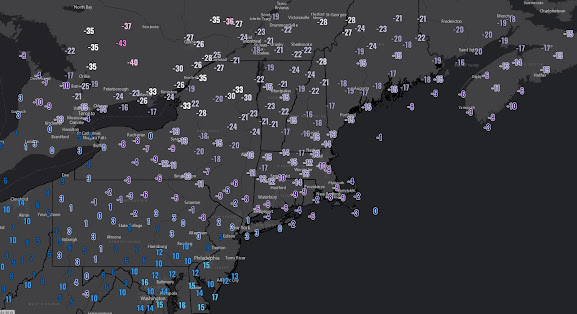We've found our groove here late in February, procuring a nice Sunday evening surprise and giving me the chance to post a gif from one of the best movies ever made.
And yes, there's more to come. Though the February finale snow will not be the epic storm I hoped it would, it still looks to be a decent event. The big precipitation producing Midwest storm will transition part of its energy to the coast very early Tuesday. The coastal low pressure center never will achieve any notable intensity, but it will have a nice little pair of scissors and effectively slice off any push of mild temperatures before it reaches New England. The MRV high country will be left with some steady snowfall beginning around dawn Tuesday and persisting through part of Tuesday evening. The snow will be mostly light but steady enough to yield an additional 4-7 inches. The snow might be a little wet in valley locations (where lesser amounts are expected) but higher elevations will see a drier snow consistency producing another outstanding ski day.
We've got more excitement in this outlook and its not that far away. Any early sunshine is expected to give way to more cloudiness on Wednesday and eventually some additional snowfall Wednesday evening. Temperatures will be a bit warmer during this round of precipitation and the snow will thus be a little wetter. Temperatures will actually rise above the freezing mark during the day Wednesday, as we greet the month of March, and are only likely to hover around the freezing mark Wednesday night with the 1-3 inches of snow we can expect before the ski day on Thursday. The snowfall Wednesday night comes from the first of two pieces of another major storm in the southern Rockies. What a season they've had down there and after depositing another couple feet of snow on the San Juan Mountains along with a few other places, this 2nd more vigorous piece of the storm will approach New England this upcoming Friday March 3rd.
We have narrowed the range of storm tracks quite substantially for the storm late Friday, but most importantly, we got a northward shift to accompany this and are now looking at the likelihood of one of the better storms of the season. The low pressure center has the look of a southwest to northeastward moving "Miller B" type storms but this very optimal track will spread heavy snow over northern Vermont late in the ski day on Friday, with snow persisting into Friday night and Saturday. An early guess would be for a 1-2 foot type event and some additional clarity can certainly be gained once a final storm track is established. As of Monday afternoon, it certainly appears that the upcoming weekend will be the best of the season with temperatures now likely to remain below freezing across the high country both Saturday and Sunday.
Every period continues to trend in a cooler direction over the next 2-3 weeks and although we still might see an above freezing afternoon, such as the one we expect Wednesday and again next Monday, the idea of a March melt-off appears delayed until after mid-March. The next chance for some snow appears to be late Monday (March 6th) into Tuesday the 7th and then the jet will undergo a more substantial jet amplification by Friday, March 10th. The recent -PDO years have really limited these type of jet stream regimes over North America, but this appears to be a very impressive -EPO period and it will ensure an extended stretch of below normal temperatures across a broad area of North America as NWS has foretasted a few days ago while also setting the stage for additional east coas weather drama. The relative SST warmth of the western Atlantic Ocean is just another stick of dynamite.




